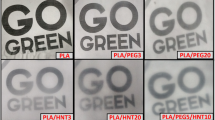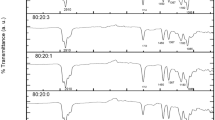Abstract
To evaluate the potential of halloysite nanotubes (HNT) as nanofiller for polylactide (PLA), various nanocomposites have been successfully produced by melt-blending the polyester matrix with HNT (HNT(QM)). HNT were also surface treated by silanization reaction with 3-(Trimethoxysilyl) propyl methacrylate (TMSPM). The morphology, thermal, tensile and impact strength properties of the nanocomposites containing 3–12 % HNT were evaluated and compared to those of pristine (unfilled) PLA. The nanocomposites were characterized by higher rigidity (with Young’s modulus increasing with HNT loading), higher tensile strength (about 70 MPa at 6 % HNT(QM)), whereas the elongation at break and impact strength did not decrease. As demonstrated under dynamic solicitation (DMA), melt-blending PLA with HNT led to enhancement of storage modulus (E′) and offers the possibility to use PLA in applications requiring higher temperatures of utilization. However, with few exceptions, TGA and DSC measurements did not reveal important changes of thermal parameters. The surface silanization treatment proved to improve the quality of the nanofiller dispersion even at higher loading. As a result, good thermal stability associated to high tensile strength, and noticeable increases in impact properties were recorded. Furthermore, enhanced nucleating ability and crystallization kinetics of the PLA matrix were revealed as specific characteristics.









Similar content being viewed by others
References
Platt D (2006) Biodegradable polymers—market report. Smithers Rapra Limited UK, Shawbury
Drumright RE, Gruber PR, Henton DE (2000) Polylactic acid technology. Adv Mater 12(23):1841–1846
Madhavan Nampoothiri K, Nair NR, John RP (2010) An overview of the recent developments in polylactide (PLA) research. Biores Tech 101(22):8493–8501
Dubois Ph, Murariu M (2008) The “green” challenge: high performance PLA (nano)composites. JEC Compos Mag 45:66–69
Vink ETH, Rábago KR, Glassner DA, Gruber PR (2003) Applications of life cycle assessment to NatureWorks™ polylactide (PLA) production. Polym Degrad Stabil 80(3):403–419
Ravenstijn J (2010) The state-of-the-art on bioplastics products: markets, trends, and technologies. Polymedia Publisher GmbH
Pluta M (2004) Morphology and properties of polylactide modified by thermal treatment, filling with layered silicates and plasticization. Polymer 45(24):8239–8251
Solarski S, Ferreira M, Devaux E, Fontaine G, Bachelet P, Bourbigot S et al (2008) Designing of polylactide/clay nanocomposites for textile applications: effect of processing conditions, spinning and characterization. J Appl Polym Sci 109(2):841–851
Murariu M, Da Silva Ferreira A, Degée Ph, Alexandre M, Dubois Ph (2007) Polylactide compositions. Part 1: effect of filler content and size on mechanical properties of PLA/calcium sulfate composites. Polymer 48(9):2613–2618
Bleach NC, Nazhat SN, Tanner KE, Kellomäki M, Törmälä P (2002) Effect of filler content on mechanical and dynamic mechanical properties of particulate biphasic calcium phosphate-polylactide composites. Biomaterials 23(7):1579–1585
Murariu M, Bonnaud L, Yoann P, Fontaine G, Bourbigot S, Dubois Ph (2010) New trends in polylactide (PLA)-based materials: “Green” PLA-calcium sulfate (nano)composites tailored with flame retardant properties. Polym Degrad Stabil 95(3):374–381
Dubois Ph, Murariu M, Alexandre M, Degée Ph, Bourbigot S, Delobel R, Fontaine G, Devaux E (2008) Polylactide-based compositions. WO patent 095874 Al
Murariu M, Da Silva Ferreira A, Duquesne E, Bonnaud L, Dubois Ph (2008) Polylactide (PLA) and highly filled PLA-calcium sulphate composites with improved impact properties. Macromol Symp 272(1):1–12
Murariu M, Da Silva Ferreira A, Alexandre M, Dubois Ph (2008) Polylactide (PLA) designed with desired end-use properties: 1. PLA compositions with low molecular weight ester-like plasticizers and related performances. Polym Adv Technol 19(6):636–646
Anderson KS, Schreck KM, Hillmyer MA (2008) Toughening polylactide. Polym Rev 48:85–108
Jamshidian M, Tehrany EA, Imran M, Jacquot M, Desobry S (2010) Poly-lactic acid: production, applications, nanocomposites, and release studies. Compr Rev Food Sci Food Saf 9(5):552–571
Sinda Ray S, Yamada K, Okamoto M, Ogami A, Ueda K (2003) New polylactide/layered silicate nanocomposites 3 High-performance biodegradable materials. Chem Mater 15(7):1456–1465
Fukushima K, Tabuani D, Camino G (2009) Nanocomposites of PLA and PCL based on montmorillonite and sepiolite. Mater Sci Eng C 29(4):1433–1441
Villmow T, Potschke P, Pegel S, Haussler L, Kretzschmar B (2008) Influence of twin-screw extrusion conditions on the dispersion of multi-walled carbon nanotubes in a poly(lactic acid) matrix. Polymer 49(16):3500–3509
Bourbigot S, Fontaine G, Gallos A, Bellayer S (2011) Reactive extrusion of PLA and of PLA/carbon nanotubes nanocomposite: processing, characterization and flame retardancy. Polym Advan Technol 22(1):30–37
Murariu M, Dechief AL, Bonnaud L, Paint Y, Gallos A, Fontaine G, Bourbigot S, Dubois Ph (2010) The production and properties of polylactide composites filled with expanded graphite. Polym Degrad Stabil 95(5):889–900
Fukushima K, Murariu M, Camino G, Dubois Ph (2010) Effect of expanded graphite/layered-silicate clay on thermal, mechanical and fire retardant properties of poly(lactic acid). Polym Degrad Stabil 95(6):1063–1076
Goffin AL, Duquesne E, Moins S, Alexandre M, Dubois Ph (2007) New organic–inorganic nanohybrids via ring opening polymerization of (di)lactones initiated by functionalized polyhedral oligomeric silsesquioxane. Eur Polym J 43(10):4103–4113
Murariu M, Doumbia A, Bonnaud L, Dechief AL, Paint Y, Ferreira M, Campagne C, Devaux E, Dubois Ph (2011) High-performance polylactide/ZnO nanocomposites designed for films and fibers with special end-use properties. Biomacromolecules 12(5):1762–1771
Du M, Guo B, Jia D (2010) Newly emerging applications of halloysite nanotubes: a review. Polym Int 59(5):574–582
Marney DCO, Russell LJ, Wu DY, Nguyen T, Cramm D, Rigopoulos N, Wright N, Greaves M (2008) The suitability of halloysite nanotubes as a fire retardant for nylon 6. Polym Degrad Stabil 93(10):1971–1978
Prashantha K, Schmitt H, Lacrampe MF, Krawczak P (2011) Mechanical behaviour and essential work of fracture of halloysite nanotubes filled polyamide 6 nanocomposites. Compos Sci Technol 71(16):1859–1866
Hedicke-Höchstötter K, Lim GT, Altstädt V (2009) Novel polyamide nanocomposites based on silicate nanotubes of the mineral halloysite. Compos Sci Technol 69(3–4):330–334
Mingliang D, Baochun G, Demin J (2006) Thermal stability and flame retardant effects of halloysite nanotubes on poly(propylene). Eur Polym J 42(6):1362–1369
Liu M, Guo B, Du M, Chen F, Jia D (2009) Halloysite nanotubes as a novel β-nucleating agent for isotactic polypropylene. Polymer 50(13):3022–3030
Prashantha K, Lacrampe MF, Krawczak P (2011) Processing and characterization of halloysite nanotubes filled polypropylene nanocomposites based on a masterbatch route: effect of halloysites treatment on structural and mechanical properties. Express Polym Lett 5(4):295–307
Zhao M, Liu P (2008) Halloysite nanotubes/Polystyrene (HNT/PS) nanocomposites via in situ bulk polymerization. J Therm Anal Calorim 94(1):103–107
Liu M, Guo B, Du M, Cai X, Jia D (2007) Properties of halloysite nanotube-epoxy resin hybrids and the interfacial reactions in the systems. Nanotechnology 18(45):455703
Deng S, Zhang J, Ye L (2009) Halloysite–epoxy nanocomposites with improved particle dispersion through ball mill homogenisation and chemical treatments. Compos Sci Technol 69(14):2497–2505
Fleischer C, Daly R, Wagner A, Kelley D, Duffy M (September 17, 2008) Clay nanotubes in polymer composites: a route to stronger, lighter & less expensive materials. In: 8th annual SPE automotive composites conference & exhibition, Michigan
Cooper S, Fleischer C, Michael D, Aaron W (2011) Polymeric composite including nanoparticle filler. United States Patent 2011/0160345 A1
Cooper S, Fleischer C, Michael D, Aaron W (2011) Polymeric composite including nanoparticle filler, United States Patent 7,888,419 B2
***HNT™-QM, MSDS—material safety data sheet 0023, August 6, 2007
Sadler EJ, Vecere AC (1995) Silane treatment of mineral fillers-practical aspects. Plast Rub Compos Pro 24(5):271–275
Cervantes-Uc JM, Cauich-Rodriguez JV, Vazquez-Torres H, Garfias-Mesias LF, Paul DR (2007) Thermal degradation of commercially available organoclays studied by TGA-FTIR. Thermochim Acta 457(1–2):92–102
Quantin P, Herbillon AJ, Janot C, Siefferman G (1984) L’halloysite blanche riche en fer de vate (Vanuatu). Hypothese d’un edifice interstratifié halloysite-hisingerite. Clay Miner 19:629–643
Yuan P, Southon PD, Liu Z, Green ME, Hook J, Antill SJ, Kepert CJ (2008) Functionalization of halloysite clay nanotubes by grafting with gamma-aminopropyltriethoxysilane. J Phys Chem C Nanomater Interfaces 112(40):15742–15751
***Guide to Silane Solutions from Dow Corning. (Dow Corning Corporation, 2005) http://www.talleresnorte.com.ar/pdf/pinturas/silanos/silane_guide.pdf
Lecouvet B, Gutierrez JG, Sclavons M, Bailly C (2011) Structure property relationships in polyamide 12/halloysite. Polym Degrad Stabil 96(2):226–235
Yasuniwa M, Tsubakihara S, Sugimoto Y, Nakafuku C (2004) Thermal analysis of the double-melting behavior of poly(l-lactic acid). J Polym Sci Part B Polym Phys 42(1):25–32
Su Z, Li Q, Liu Y, Hu G-H, Wu C (2009) Multiple melting behavior of poly(lactic acid) filled with modified carbon black. J Polym Sci Part B Polym Phys 47(20):1971–1980
Pluta M, Murariu M, Alexandre M, Galeski A, Dubois P (2008) Polylactide compositions The influence of ageing on the structure, thermal and viscoelastic properties of PLA/calcium sulfate composites. Polym Degrad Stabil 93(5):925–931
Handge UA, Hedicke-Höchstötter K, Altstädt V (2010) Composites of polyamide 6 and silicate nanotubes of the mineral halloysite: influence of molecular weight on thermal, mechanical and rheological properties. Polymer 51(12):2690–2699
Deng S, Zhang J, Ye L, Wu J (2008) Toughening epoxies with halloysite nanotubes. Polymer 49(23):5119–5127
Oyama HT (2009) Super-tough poly(lactic acid) materials: reactive blending with ethylene copolymer. Polymer 50(3):747–751
Acknowledgments
Authors thank the Wallonia Region, Nord-Pas de Calais Region and European Community for the financial support in the frame of the IINTERREG IV—NANOLAC project. They thank all partners, especially to Professor Serge Bourbigot (ENSC Lille), Professor Eric Devaux (ENSAIT- Roubaix, France) and their collaborators, for helpful discussions and all mentioned companies for supplying raw materials. This work was also supported by the European Commission and Région Wallonne FEDER program (Materia Nova) and OPTI²MAT program of excellence, by the Interuniversity Attraction Pole program of the Belgian Federal Science Policy Office (PAI 6/27) and by FNRS-FRFC.
Author information
Authors and Affiliations
Corresponding authors
Rights and permissions
About this article
Cite this article
Murariu, M., Dechief, AL., Paint, Y. et al. Polylactide (PLA)—Halloysite Nanocomposites: Production, Morphology and Key-Properties. J Polym Environ 20, 932–943 (2012). https://doi.org/10.1007/s10924-012-0488-4
Published:
Issue Date:
DOI: https://doi.org/10.1007/s10924-012-0488-4




